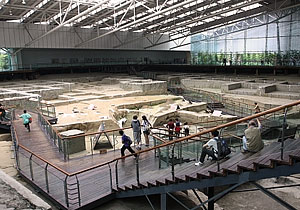Jinsha Relics Museum

In February 2001 an area of construction work in the village of Jinsha was halted when workers unearthed what is now regarded as "the most significant archaeological discovery in the 21st century in China" Today on that site around 5km from Chengdu center on the south-east edge of the Chengdu Plain, stands the "Jinsha Relics Museum". Built on an area of 300,000 square meters, the museum is the largest in Sichuan though the buildings only take up 35,000 square meters. Five sections make up the museum - the Tourist Centre, the Relic Hall, the Exhibition Hall, the Protection Centre of Cultural Relics and the Garden District.
Although Jinsha culture can be traced back to the late Shang Dynasty (1700BC – 1100BC), the thousands of relics excavated from the site are dated to the Kingdom of Shu ( 221 - 263 ). Examples of the relics on display in the museum include instruments, gold plates, jade sculptures, stone sculptures and pieces made from wood, clay, bronze and ivory. The relic the museum is most proud of is "the Solar Divine Bird" which was chosen to be the symbol of Chinese cultural heritage.
The museum grounds are a beautiful place to wander around as trees and green areas make up the majority of the area. Such places as the Jade Path and Ebony Forest are there to be discovered. Jinsha Relics Museum is a modern museum filled with some of Chinas oldest and best relics, a place not to be missed for anyone interested in Chinese ancient culture.